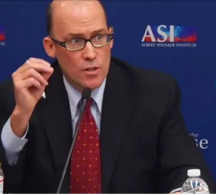Coffee Talk with Peter Cunningham, executive director of Education Post and Richard Kahlenberg of The Century Foundation. Originally posted on Education Post 3/16/17.
 Richard Kahlenberg is perhaps the nation’s leading proponent of the idea that for kids to succeed, schools must be places where families of all economic backgrounds come together. A senior fellow at The Century Foundation, he is also a leading authority on many other aspects of K-12 and higher education.
Richard Kahlenberg is perhaps the nation’s leading proponent of the idea that for kids to succeed, schools must be places where families of all economic backgrounds come together. A senior fellow at The Century Foundation, he is also a leading authority on many other aspects of K-12 and higher education.
His most recent book, co-authored with Halley Potter, “A Smarter Charter: Finding What Works for Charter Schools and Public Education,” examines two myth-busting strategies in a small but growing number of charter schools: promoting economic diversity in enrollment and amplifying teacher voice. He talked with us about innovative ways schools of all kinds can increase economic diversity in their schools and why that’s important for children in poverty.
Are you a tea or coffee drinker? How do you take it?
Even with a new testosterone-driven administration in power, I’m not afraid to say I drink tea with sugar.
You’ve focused a lot of your recent work on economic integration of public schools. Why is it important, where is it happening and how does it work?
The 1966 Coleman Report—the granddaddy of education studies—found that the biggest predictor of academic achievement is the socioeconomic status of the family a child comes from and the second biggest predictor is the socioeconomic status of the school she attends. Low-income students given a chance to attend middle class schools are as much as two years ahead of low-income students stuck in high-poverty schools on the National Assessment of Educational Progress in math. Sophisticated studies using random assignment find very powerful positive effects on student achievement when low-income students attend middle-class schools.
What’s frustrated me is that while there is a social science consensus that poverty concentrations are bad for education, there is also an outdated political consensus that there is nothing we can do about it. We’ve learned a lot about how to integrate schools since the days of compulsory busing for racial desegregation that fostered such a backlash.
Today, most districts use choice and incentives—like non-selective magnet schools—to promote diversity. And the trend is to emphasize socio-economic as well as racial diversity because using economic status avoids the legal problems associated with using race and because social science research suggests it is the economic status of classmates that most powerfully correlates with academic achievement.
Today, 100 school districts and charter schools in 32 states have adopted conscious plans to allow rich and poor kids to go to school together and learn from one another. In places like Cambridge, Massachusetts, which uses choice to achieve economic diversity in its schools, graduation rates for low-income, Black and Hispanic students are as much as 20 percentage points higher than for comparable groups in nearby Boston. And White students do better in Cambridge, too. Indeed, a growing body of research suggests middle-class and White students benefit because diverse learning environments make us all smarter.
EdBuild has done some work on how economic classes are segregated by school boundaries. What would it take to have economically-integrated schools at scale? Would urban and suburban districts ever consolidate?
I’m on EdBuild’s research advisory board and I think they’re doing fabulous work exposing economic segregation. EdBuild has noted that there are glaring economic inequalities even between some jurisdictions that sit right next to one another.
TAKING ECONOMIC INTEGRATION TO SCALE, ULTIMATELY REQUIRES THAT WE MOVE BEYOND ARTIFICIALLY SET BARRIERS AND WALLSTaking economic integration to scale, ultimately requires that we move beyond artificially set barriers and walls that have been constructed between cities and suburbs in the minds of policymakers. Several metropolitan areas, including Hartford, Connecticut; St. Louis, Missouri; Boston, Massachusetts; Omaha, Nebraska; Rochester, New York and Minneapolis, Minnesota, have longstanding and successful school integration programs that reach across traditional school district lines.
Other districts, like Wake County (Raleigh), North Carolina and Louisville (Jefferson County), Kentucky, have successful school integration programs that encompass city and suburb within a single jurisdiction. We’ve heard a lot about building new walls in the election season, but we really should be knocking down artificial school district walls that separate kids by race and class.
Are public charters one tool to achieve this outcome or are they impeding economic integration? Broadly speaking, do parents need more choice in public education?
Yes, yes and yes. Charters, in theory, and sometimes in practice, can be a powerful engine for economic school integration. As my colleague Halley Potter and I note in our book, Albert Shanker, the president of the American Federation of Teachers, proposed charter schools in 1988 as places where teachers could experiment with new ideas and where students of different backgrounds could learn from one another. His model was a school in Cologne Germany where Turkish immigrant and German native students sat side by side and both groups benefited.
Unfortunately, many charter schools today are even more segregated than traditional public schools—which is a pretty difficult thing to be. Having said that, we profile in the book a small but growing number of charter schools that are intentionally diverse—the Denver School of Science and Technology, High Tech High in San Diego, City Neighbors in Baltimore, Morris Jeff in New Orleans, Blackstone Valley Prep in Rhode Island, Capital City and E.L. Haynes in Washington, D.C., Community Roots in Brooklyn and Larchmont in Los Angeles.
There are two ways to integrate schools: through public school choice that overcomes neighborhood segregation by race and class; and through housing integration that makes neighborhood schools integrated institutions. We need to push forward on both fronts.
You’ve argued in defense of teachers unions, who have been both partners in improving schools, but also opponents of reforms like accountability and choice. On balance are unions helping more than hurting? What’s their likely posture in the Trump/DeVos era?
Teachers unions are one of the most misunderstood institutions in American society. In writing Tough Liberal: Albert Shanker and the Battles Over Schools, Unions, Race and Democracy, I came to realize what life was like before unions had any real power. Teachers were even more poorly paid than they are today and had very little dignity, which was not good for students. Teachers unions changed that. The highest-quality studies suggest that achievement among students is stronger in places where teachers unions are strong.
One silver lining in the Trump/DeVos era is that progressives may finally wake up and come to realize the importance of teachers unions in standing up against the privatization of American education. There will be lots of important allies in the defense of public education—superintendents, principals, public school parents and students, civil rights groups—but only the teachers unions have the political muscle to defend the institution of public education that is so vital for our democracy.
I recently wrote a piece lamenting resegregation by race of public education and asking if it is worth the fight. School boundaries mostly align with segregated housing patterns and efforts to integrate schools—like busing—have stalled. And there’s some evidence that people of color care less about integration than educational quality. What are your thoughts about integration, especially in today’s political environment?
It’s false to suggest that educational quality and integration are disconnected ideas. Middle-class schools are 22 times as likely to be high performing as high-poverty schools, in part because disadvantaged students face extra obstacles, but in part because economic segregation has an independent, negative effect on student achievement.
INTEGRATED SCHOOLING IS MORE IMPORTANT THAN EVER.In today’s political environment, integrated schooling is more important than ever. Integrated schools make it more difficult for demagogues to run for office by scapegoating minorities. Integrated schools raise achievement that fuels social mobility.
After one of the most divisive elections in memory, we desperately need integrated schools that remind school children what they have in common as Americans.
Donald Trump will likely set back federal efforts for school integration, but the 100 school districts promoting economic diversity mostly created their plans on their own and school districts can continue to do so in the age of Trump. I worked with Michael Alves and John Brittain to help Charlotte-Mecklenburg schools develop an economic integration program for their dozens of magnet schools. The day after Trump was elected, the Charlotte School board voted 9-0 in support of a plan to move beyond “separate but equal” schooling and adopted an economic diversity program that is good for students, good for teachers and good for the community.
Progressives should seize upon the rhetoric of Trump and DeVos—that poor kids trapped in failing schools deserve something better—to advocate on behalf of public school choice that intentionally promotes integrated schools. Five decades of research suggests this approach will be far more effective in helping kids than private school voucher plans that are receiving so much attention.
Share this:
- More





